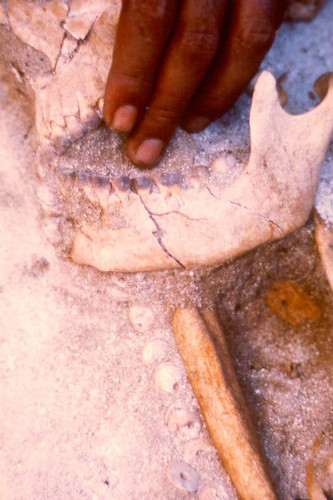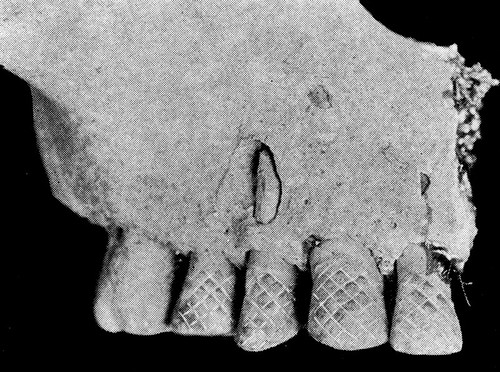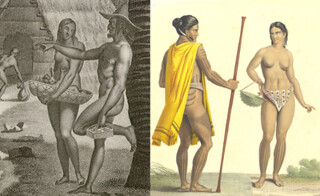Table of Contents
Share This
Tooth staining
Unlike clothing or hairstyles, body modifications are changes made to the body itself that are of a more permanent nature. Among the CHamoru/Chamorro people, the most remarkable examples of these kinds of modifications were tooth etching and staining. The Spanish missionaries described women as going to great lengths to stain their teeth as a sign of beauty.
While betel nut chewing itself will stain teeth, the CHamorus did it purposefully, especially on the tooth’s visible surface. This purposeful staining was achieved by applying other substances, in a process mentioned by the missionary, Father Peter Coomans. He wrote:
In order to do this, they mix black coloring with some gum to make it long-lasting. They often reserve an entire day to anoint that one tooth…[the entire process] will take up as many as 14 days, during which time the teeth must not touch anything. That is why they suffer continuous torment, with only a funnel used to give sustenance to their body so they do not die.
It is likely that tooth staining was a process associated with elite or high status CHamorus, as afterwards, a feast would be given to celebrate the occasion.
Tooth etching
An even more striking modification was tooth etching. Etching the tooth surface involved cutting or incising lattice-like grooves into the surface of stained incisors (or front teeth) to produce a decorative effect. The grooves were etched only on the visible surfaces of the teeth. Only a few tooth remains dating from the late prehistoric period of the Marianas have been found that actually exhibit etching, but it was not described in accounts by Spanish explorers. As historian Scott Russell notes, there is no evidence of the tools or techniques available in accounts or the archeological record to explain how or why this practice emerged.
Tooth sharpening
There is at least one account from the 16th century that mentions another type of modification―tooth sharpening. In this description of the faces of the natives, the author wrote:
The mouth is very big and the teeth are sharpened like those of a dog, and more so, and they stain them with a red varnish that cannot be removed and which is to preserve their set of teeth … This is something that the Moros of this land [i.e., the Philippines] do as well.
The author does not mention how or why this was done, but the practice apparently died out in the years preceding the establishment of the Catholic mission by Fr. Diego Luis de San Vitores in the late 17th century.
No records of tattooing
Tattooing is probably the most well-known type of modification recorded among different cultures, including Micronesian islanders. However, it is uncertain if the CHamorus practiced tattooing themselves. There are no records of tattooing observed by the early Spanish explorers, nor have traditional tools been identified that might have been used to color the skin.
Archeologist Rosalind L. Hunter-Anderson asserts, however, that this lack of evidence in CHamoru culture does not necessarily mean the CHamorus never marked their skin with tattoos. She looks to evidence from nearby, related cultures in Micronesia, including Yap and Palau, that have tattooing traditions. Hunter-Anderson also puts forth the possibility that the practice may have died out prior to the arrival of Europeans, and therefore, no record would remain. She notes, though, that perhaps the particular social and cultural circumstances of the CHamorus made tattooing an unnecessary practice for distinguishing social classes or restricting members of society, as is often the purpose of tattoo traditions.
In any case, people today are still fascinated by the ornamental practices of the CHamoru people, from jewelry, to clothing to body modification, and try to incorporate it into designs and fashion.
For further reading
Cunningham, Lawrence J. Ancient Chamorro Society. Honolulu: Bess Press, 1992.
Freycinet, Louis Claude Desaulses de. An Account of the Corvette L’Uraine’s Sojourn at the Mariana Islands, 1819. Translated by Glynn Barratt. Saipan: Commonwealth of the Northern Mariana Islands Division of Historic Preservation, 2003.
Hunter-Anderson, Rosalind L. “On the Question of Tattoo by Ancestral CHamorus.” In Guampedia, last modified 18 December 2019.
Yatar, Maria Santos. With the First Canoe: Traditional Tatu of Micronesia. 1992.



